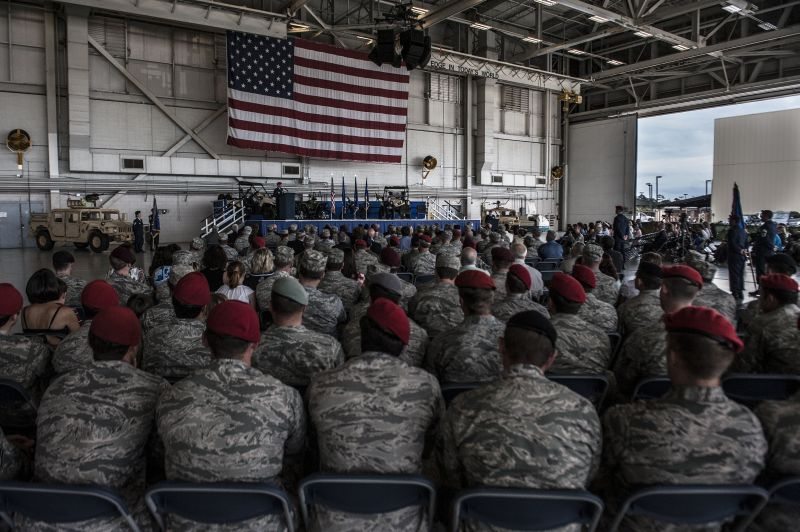Despite a congressional budget deal that lessens the impact of sequestration on the Air Force, it doesn’t go far enough to halt actions to shrink the service, senior service officials said.
Under Secretary of the Air Force Eric Fanning and Gen. Mark A. Welsh III, the Air Force chief of staff, said that even with some relief from sequestration, the service will still have to reduce its force structure and sacrifice modernization and readiness.
How this occurs will affect what the service will look like in 2023, when sequestration ends, they said.
The proposed budget deal making its way through Congress would mitigate some near-term readiness problems, Welsh said, and Air Force leaders will put any money Congress approves beyond sequestration into training and maintenance accounts.
The budget agreement, which was months in the making, eases spending caps for the next two fiscal years while softening the impact of across-the-board spending cuts, known as the sequester, on defense and non-defense programs.
Overall, the agreement calls for more than $20 billion in deficit reduction.
Still, Welsh said, this doesn’t change the long-term picture, noting that sequestration poses a dilemma for the Air Force. Does the service choose to keep near-term readiness high at the expense of force modernization, or vice versa?
“That’s the balance we’re trying to walk,” the general said.
One example of this conundrum is the close air support mission. The Air Force is studying proposals on how best to carry out this core mission, the general said. One proposal would eliminate the A-10 Thunderbolt II close air support aircraft — the aircraft Welsh flew as a young pilot.
If money were no object, the A-10 would be a great platform to retain, the general said. But money is tight, he noted, and will be tighter.
“To pay our $12 billion-a-year bill toward sequestration, we have got to find savings in big chunks,” Welsh said. “That’s the problem. And that’s what all these discussions are based on. It’s not about a specific platform. It’s about balancing the mission sets.”
The general said other aircraft — F-16 Fighting Falcons, B-1 Lancers and B-52 Stratofortresses — provide roughly 75 percent of the close air support in Afghanistan today.
“We have a lot of airplanes that can perform that mission and perform it well,” he said. “Those other aircraft do other things for us.”
The Air Force ultimately will replace the A-10 with the F-35 Lightning II joint strike fighter, Welsh said.
“That plan hasn’t changed,” he added.
Saving money also is important, he said.
“To do that, you have to start talking about fleet divestitures, because you have to get rid of the infrastructure behind the aircraft — the logistics tail, the supply systems, the facilities that do all the logistical support and depot maintenance, et cetera,” he said. “That’s where you create big savings.”
Changing force structure also will inevitably change the service, Welsh said.
“We will have to draw down people — both the tooth and the tail that comes with that force structure,” he said.
Personnel policies will be used to shape the force, and the service is getting these policies out to Airmen now so they can make informed decisions, Welsh said.
“We’d love to get all this done with voluntary force-shaping measures over a period of time,” he said. “If we … have to take involuntary measures, I would like everyone to have at least six months of time to talk to their family (and) to think about the impact this could have on them.”
With only operations and maintenance and investment accounts remaining for quick assessment, a profound impact to readiness could ensue.
“The Air Force was already in a 20-year readiness decline, something we were just starting to address when sequestration hit,” said Fanning, adding that the service’s size and structure doesn’t lend itself to a tiered readiness model.
“When the flag goes up, the Air Force is expected to get to the crisis rapidly,” he said. “Speed is a key advantage of airpower.”
The number of Air Force squadrons equals the combatant commanders’ requirements, Fanning said, but with little or no time built into plans to bring forces up to full readiness.
“If it takes months to generate combat air power, the president loses deterrence, diplomatic influence and contingency options on which the nation has come to depend,” he said.
Fanning characterized budget compromises currently in debate on Capitol Hill as encouraging, though lower than service officials would like. The additional funds over the next two years will help cover readiness shortfalls, stability and planning, he said.
“Even with this relief, we will need to resize the Air Force to one that is smaller than it is today in order to protect investments we need for the future and to shape an Air Force that we can keep ready; we can’t do these cuts individually, ad hoc, or in isolation,” Fanning said. “If something’s restored to the budget we present to the Hill, something else will need to go.”
Still, Fanning pledged a continued commitment to helping Airmen get past the “distractions” of budget and political uncertainty.
“We will make the decisions that we can, as quickly as we can, as transparently as we can … to get the Air Force back to that ‘new normal,’” he said.










